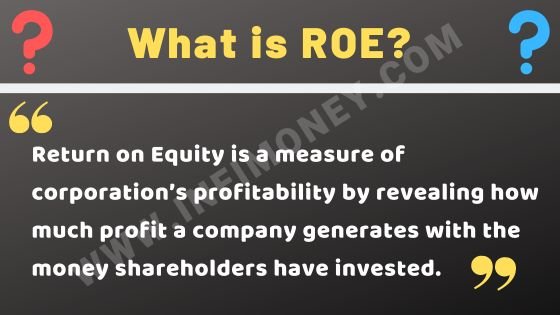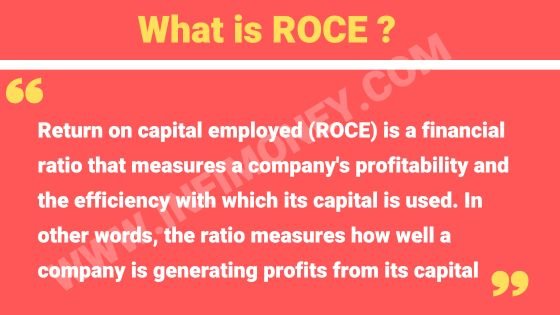ROE and ROCE are two measures to analyse the capital efficiency of a company. Both these ratios tell you how well a company is utilizing its resources, to generate profit.
Using Roe and ROCE gives investors a deeper insight into the financial health of the company.
In this post you will learn about ROE and ROCE and how you can use these financial ratios to analyse a stock and make intelligent investment decisions.
Before you jump into analysing stocks using ROE and ROCE, it important that you understand what they mean and what do they signify?
Let us begin with ROE and understand what it is.
What is ROE?

The formula for ROE is as follows:
ROE = Net income (Profit After Tax) / Shareholder’s Equity
So, for example if I have invested Rs.100 in a business and earn a profit of Rs.10 on it, my ROE would be 10/100=10%.
Higher ROE indicates that company is able to generate higher profit by utilizing its funds more efficiently, thus generating higher profits.
Does that mean that higher ROE is a guarantee of better utilization of funds and you should blindly invest in a company with high ROE? The answer is no. Why? Because ROE does not consider the amount of debt a company has while analyzing the capital efficiency of the company, which makes a huge impact on the ROE of the company. Let me explain how.
Consider the examples of 4 companies namely A, B, C, and D.
Example 1
Company A has Shareholders equity of 100 and has zero debt, the Profit Before Tax (PBT) of the company is Rs.15.
Since there is no debt, the interest cost is zero, after deducting tax (assuming tax to be 30% of Profit), the Profit After Tax for Company A is Rs.10.5.
As a result, the ROE of the company is 10.5%.
Example 2
In the second example, we will assume that Company B has a Shareholder Equity of Rs.80 and has a debt of Rs.20. In this case, the EBIT of the company is Rs.15 while the interest expense is Rs.2 (@10% of the total debt).
Post interest expenses, the Profit Before Tax (PBT) is Rs.13 and after deducting the tax expenses, the Profit After Tax is at Rs.9.1.
As a result, the ROE of Company B is at 11.4%
Now there are two interesting observations that you should pay attention to.
First, the change in capital structure of the company from being 100% funded by Equity to 80% equity and 20% debt, the ROE has seen a good growth from 10.5% in case of Company A to 11.4% in case of Company B, as the equity capital base narrowed.
However, the second observation is that the increase in ROE comes at the cost of lower Profit After Tax (PAT), where the PAT declined from Rs.10.5 in case of Company A to Rs.9.1 in case of Company B.
Let’s proceed with the other remaining examples and see how higher debt impacts various financial aspects of the company, especially ROE.
Example 3
Company C has a Shareholder equity of Rs.50 and a debt of Rs.50. In this case, the EBIT remains at Rs.15, because of the higher proportion of debt the interest expenses increase from Rs.2 in the previous example to Rs.5 in this example.
As a result of rising interest expense, the Profit Before Tax (PBT) goes down to Rs.10 and post-tax expenses, the PAT is at Rs.7. However, because of the lower shareholder contribution towards funding the business, the ROE sees a rise from 11.4% in the previous example to 14%.
Let’s move on to our final example of Company D, where you will see how, high leverage impacts the ROE and other aspects of a company.
Example 4:
Company D has a Shareholder’s Equity of Rs.20 and debt of Rs.80. as a result, due to higher interest expenses, which moves further up from Rs.5 in the previous example to Rs.8 now, the PBT comes down from Rs.7 to Rs.4.9.
Because of the lower shareholder contribution, the ROE jumps from 14% in the previous case to 24.5% in the present example.
What do all the examples above tell you? There are few interesting conclusions you can get.
Some interesting observations about ROE
First, Contrary to popular opinion, rising ROE does not necessarily mean that company is utilizing its shareholder’s Equity efficiently, rising ROE may also mean that company is leveraging its balance sheet by taking on debt on its books and reducing the overall contribution of the shareholders.
One of the sure signs that rising ROE is hurting a company can be found if you look at the combination of ROE and PAT, if the ROE is rising while the PAT is declining, it’s a sure sign that the balance sheet of the company is highly leveraged and if the profits of the company decline, it will have a huge negative impact on the profits of the company.
Having understood ROE in detail, let us now move on to the other financial ratio called Return on Capital Employed (ROCE):
What is ROCE?

The formula for ROCE is as follows:
ROCE = EBIT / Total capital Employed
Where EBIT = Earnings Before Interest and Taxes
Total Capital Employed = Total Debt + Shareholder’s Equity
If you observe the formula carefully, you will find two interesting observations. First, unlike ROE, which measures the capital efficiency on the basis of total capital employed which includes both debt and equity and not just shareholder’s funds.
ROCE is usually assumed to be a better metric for measuring the capital efficiency. Higher the ROCE, better the capital efficiency of the company. However, just like ROE, even ROCE has some limitations, what are they? Let us understand using similar examples we used for ROE.
Example 1:
Company A has Shareholders Equity of Rs.100 and has zero debt, The company has an EBIT of Rs.15, so as per the given formula the ROCE of Company A is 15/100 =15%
Example 2:
Company B has a Shareholder’s Equity of Rs.80 and a debt of Rs.20. As a result of the debt, the total interest expense is Rs.2 (@10% of the total debt), but since ROCE is calculated before interest and tax, despite interest expenses, ROCE remains unchanged to 15%.
What is interesting to observe here is the fact that unlike ROE, which was affected by the change in interest expenses, ROCE remains unchanged.
Something similar can be seen in the third and the fourth example as well.
Example 3:
Coming to the third example, Company C has a shareholder’s Equity of Rs.50 and debt of Rs.50as well.
The interest expenses of the company is at Rs.5 at 10% of the total debt. However, the ROCE still remains unchanged at 15%.
Even if you look at the fourth example the ROCE despite the balance sheet being highly leveraged, remains unchanged.
The final conclusion we can derive from the above example is that ROCE is largely immune to the change in the capital structure of the company, unlike ROE, which rises as the balance sheet gets higher leverage.
What can also be concluded is that depending solely on one of these ratios can give you highly misleading conclusions.
That is why it is important to use both ROE and ROCE to get a clear picture of the financial health of the company and make better and more intelligent conclusions.
ROE and ROCE: How to use them?
The question is how to use ROE and ROCE together to get a clear picture of the financial performance and capital efficiency of the stock?
To understand this, let us revisit our previous examples and look at both ROE and ROCE together and analyse the difference.
In case of example 1, since there is no debt, the difference between ROE and ROCE is narrow, the ROE in this case is at 10.5% while ROCE is at 15%.
The moment there is some leverage in the balance sheet, the gap between ROCE and ROE is narrowed as ROE is enhanced from 10.5% to 11.4%.
Higher the leverage narrower the gap between ROE and ROCE, finally, if the company is highly leveraged, ROE will be higher than ROCE due to smaller contribution of equity capital in company’s capital structure.
So how do you read ROE and ROCE? While analysing a company, you should keep few points in mind.
Point 1: Let me reiterate the most basic but the most important point. Never depend either on ROE or ROCE alone for measuring the capital efficiency of the company as both of them have their own limitations and can give biased results. In order to get a complete picture, you must analyse both ROE and ORCE before reaching any conclusion.
Point 2: Look at the ROCE and ROE numbers, if the ROCE is higher than ROE, there is a good chance that company has little or no debt on its books, to verify the facts just look at the debt of the company.
Lower debt makes the company safer bet, why? Since zero debt companies do not have to pay any interest, they can retain all the profits earned. What is a healthy ROCE number? As a thumb rule ROCE of a company should be above 15%.
Point 3: If the ROE is higher than ROCE, it can be said that the balance sheet of the company is leveraged. While high leverage is good for the company, but only if it also leads to higher profits, as company has to pay interest on the debt.
If the profit growth is higher than the interest expenses, it’s a positive sign, but if higher ROE is combined with lower PAT, the investors must get cautious because it is an indication that the company has to incur higher interest expense but is unable to use leverage efficiently to make higher profits.
Conclusion
Both ROE and ROCE are very powerful tools to measure the capital efficiency and profitability of a company.
Since both of them have a different formula for measuring capital efficiency, both of them have different sensitivity, while ROE is sensitive towards the amount of leverage the book has, ROCE is more sensitive towards change in profitability of the company.
Investors must make sure to analyse both the ratios together to understand if the company’s balance sheet is leveraged and if it is, whether it is taking advantage of the leverage by generating higher profits.
That is a wrap on our post of how to use ROE and ROCE to analyse financial health of a company. I hope you find this article knowledgeable and useful.